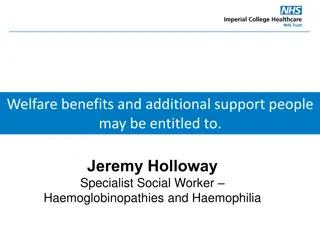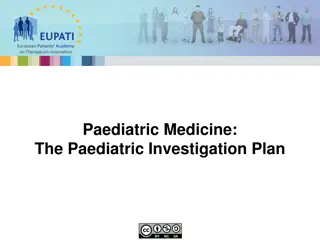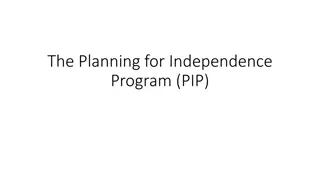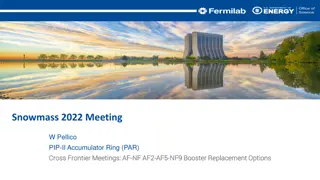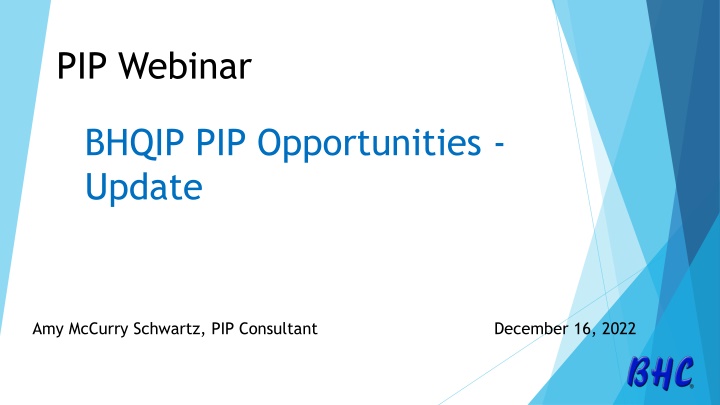
DHCS BHQIP and CMS PIP Requirements
Explore the alignment between DHCS Behavioral Health Quality Improvement Program (BHQIP) Milestone 3d and CMS Performance Improvement Project (PIP) requirements. Learn how CalEQRO validates BHQIP PIPs and get insights on problem identification, barrier analysis, and intervention planning. Discover the significance of PIP projects in achieving health outcomes and enrollee satisfaction, along with the essential steps and worksheets outlined by CMS for effective PIP implementation.
Download Presentation

Please find below an Image/Link to download the presentation.
The content on the website is provided AS IS for your information and personal use only. It may not be sold, licensed, or shared on other websites without obtaining consent from the author. If you encounter any issues during the download, it is possible that the publisher has removed the file from their server.
You are allowed to download the files provided on this website for personal or commercial use, subject to the condition that they are used lawfully. All files are the property of their respective owners.
The content on the website is provided AS IS for your information and personal use only. It may not be sold, licensed, or shared on other websites without obtaining consent from the author.
E N D
Presentation Transcript
PIP Webinar BHQIP PIP Opportunities - Update Amy McCurry Schwartz, PIP Consultant December 16, 2022
Introduction CalEQRO partnered with DHCS to align BHQIP Milestone 3d deliverables with federal Performance Improvement Project (PIP) requirements to support Behavioral Health Plan (BHP) efforts This alignment is available to all counties BHQIP Data Exchange deliverable requires baseline measurement and an implemented QI Plan to improve performance on three specified HEDIS measures
Purpose of Todays Webinar Discuss the overlap/relationship between the DHCS Behavioral Health Quality Improvement Program (BHQIP) Milestone 3d and the CMS PIP requirements Provide information on how CalEQRO will validate BHQIP PIPs Provide examples of how to: Identify a problem Conduct a barrier analysis Plan interventions
What is a PIP? CMS: A PIP is a project conducted by the BHP that is designed to achieve significant improvement, sustained over time, in health outcomes and enrollee satisfaction. A PIP may be designed to change behavior at a member, provider, and/or BHP/system level. Source: CMS External Quality Review (EQR) Protocols, October 2019, Protocol 1. Validation of Performance Improvement Projects, p. 27. DHCS requires that two active PIPs are in place during the preceding 12 months of a review.
CMS Steps and PIP Worksheets CMS STEPS 1 9 WORKSHEETS 1 9 Step 1: Identify the PIP Topic Worksheet 1: PIP Topic Step 2: Develop the Aim Statement Worksheet 2: Aim Statement Step 3: Identify the PIP Population Worksheet 3: PIP Study Population Step 4: Describe the Sampling Method Worksheet 4: Sampling Plan Step 5: Select the PIP Variables and Performance Measures Worksheet 5: PIP Variables and Performance Measures Step 6: Describe the Data Collection Procedures Worksheet 6: Improvement Strategy (Intervention) and Implementation Plan Step 7: Describe the Data Analysis and Interpretation of PIP Results Worksheet 7: Data Collection Procedures Step 8: Describe the Improvement Strategy (Intervention) and Implementation Plan Worksheet 8: Data Analysis and Interpretation of PIP Results Step 9: Address the Likelihood of Significant and Sustained Improvement Through the PIP Worksheet 9: Likelihood of Significant and Sustained Improvement Through the PIP
What is Milestone 3d Milestone 3d deliverables requires baseline measurement and an implemented QI Plan to improve performance on the following three HEDIS measures Follow-up After Emergency Department Visit for Alcohol and Drug Abuse or Dependence (FUA) Follow-up After Emergency Department Visit for Mental Illness (FUM) Pharmacotherapy for Opioid Use Disorder (POD)
Is Participation in the BHQIP PIP Required? Participation in the BHQIP PIP is OPTIONAL Counties need to meet the requirements in the DHCS reporting templates to receive BHQIP incentive payments. Counties may submit the BHQIP Milestone 3d template(s) to CalEQRO for consideration as a PIP. Counties who submit the completed DHCS templates to DHCS but choose not to participate in the BHQIP PIP will still be responsible for two MHP PIPs (all counties) and two DMC-ODS PIPs (for DMC- ODS counties).
How to Participate in the BHQIP PIP To be considered for a PIP, the BHP must submit the following, at the time of EQR document submission: For MHP PIP Credit: Completed Milestone 3d Template B (in lieu of the PIP Development tool) Evidence of PIP activity since last EQR For DMC-ODS PIP Credit: Completed Milestone 3d Template A and/or Template C (in lieu of the PIP Development tool) Evidence of PIP activity since last EQR CalEQRO will review and validate the BHQIP PIP during the scheduled annual review process
Timeline Implementation Remeasurement Analysis Closing Implementation Remeasurement Analysis Baseline Measurement & Planning
FUM Assesses emergency department (ED) visits for adults and children 6 years of age and older with a diagnosis of mental illness or intentional self-harm and who received a follow-up visit for mental illness within 7 and 30 days.
Template A, B, and C: Milestone 3d September 2022 Deliverable Template A: Milestone 3d, Sept 2022 Deliverable BHQIP Performance Improvement Project Template Follow-Up After Emergency Department Visit for Alcohol and Other Drug Abuse or Dependence (FUA) Instructions: Please fill out the following template with narratives, charts/tables, and/or graphs, as needed, and attach to submission documents when submitting September 2022 deliverables. Measure Name: Template A: Follow-Up After Emergency Department Visit for Alcohol and Other Drug Abuse or Dependence (FUA) Template B: Follow-Up After Emergency Department Visit for Mental Illness (FUM) Template C: Pharmacotherapy for Opioid Use Disorder (POD) 2. Contact Information: Behavioral Health Plan Name: Project Coordinator: Contact Email: 1. 1. 2. 3. 3. Problem Statement: what is the problem this performance improvement plan proposes to solve? Consider why change is needed, what is the chief complaint, what is the pain point, and/or what is the impact of the issue. (Response limit: one sentence)
Template A, B, and C: Milestone 3d September 2022 Deliverable 4. Who was involved in identifying the problem? (Roles, such as providers or enrollees are sufficient; proper names are not needed). How were beneficiaries or the stakeholders who are affected by/concerned with the issue included (especially emergency room providers and managed care plans)? (Response limit: 2000 characters) 5. information such as age, length of enrollment, diagnosis, and other relevant characteristics. Describe the beneficiary or enrollee population affected by the problem. Provide any available (Response limit: 2000 characters) 6. What are the potential root causes for this problem? Please insert either a fishbone diagram or 5 Whys exercise to describe this root cause analysis. 7. What specific data support the above root cause analysis? (Response limit: 2000 characters)
Template A, B, and C: Milestone 3d September 2022 Deliverable 8. How does the county s data/performance compare to HEDIS Medicaid benchmarks? (Response limit: 2000 characters) 9. What is the aim/goal for this performance improvement project? (aim statement) Describe the overall goal that your team wishes to achieve for this measure. Make sure the aim statement is specific, measurable, achievable, relevant, and time-bound (i.e., SMART). (Response limit: one sentence) 10. Briefly state the preliminary intervention(s) selected to address the root causes. (Response limit: 2000 characters) 11. Why were these interventions chosen (i.e., what evidence suggested that these interventions would address the identified causes)? (Response limit: 2000 characters) 12. Describe when and how often the interventions will be applied. (Response limit: 2000 characters)
Template A, B, and C: Milestone 3d September 2022 Deliverable 13. Provide performance metrics, including both outcome and process measures, relevant to the project. Describe how each intervention connects to these performance metrics. (Response limit: 2000 characters) 14. Please identify one or more disparities in this measure (by race, ethnicity, language, geography, age, etc.) that needs to be addressed by this performance improvement project. Provide supporting data for this disparity. (Response limit: 2000 characters) 15. How does the improvement strategy specifically help address the health disparities identified in this measure as well as the cultural and linguistic needs for the relevant beneficiaries? (Response limit: 2000 characters) 16. How are beneficiaries or the stakeholders who are affected by/concerned with the issue included in the quality improvement process? (Response limit: 2000 characters)
Template A, B, and C: Milestone 3d September 2022 Deliverable 17. Identify steps your county behavioral health plan will take in the next year to begin building capacity to collect and exchange relevant data for this measure and this performance improvement project. (Response limit: 2000 characters) 18. How will improved data exchange capabilities be leveraged in achieving this aim statement? (Response limit: 2000 characters) 19. Describe the planned systematic method for collecting and exchanging valid and reliable data. (Response limit: 2000 characters) 20. Describe the planned frequency for collecting and exchanging data. (Response limit: 2000 characters) 21. How will each of the interventions outlined in Question 10 be assessed for effectiveness and re-strategizing? How often will these assessments occur (must be at least quarterly)? (Response limit: 2000 characters)
Validation of September 2022 submission For CMS PIP credit the DHCS Milestone 3d Template A, B, C will be validated with the CalEQRO Validation Tool All PIPs submitted for BHQIP credit will be validated according to CMS Protocol 1: Validating a Performance Improvement Project BHPs will be expected to submit any additional information as requested by CalEQRO to facilitate the competition of the Validation Tool
VALIDATION TOOL TEMPLATES A, B, C SECTIONS 1 5: EQRO RESPONSIBILITY Section 1: Review the Selected PIP Topic SECTIONS 1-5: COUNTY RESPONSIBILITY Q3: Problem Statement: what is the problem this performance improvement plan proposes to solve? Q4: Who was involved in identifying the problem? Q6: What are the potential root causes for this problem? Q7: What specific data support the above root cause analysis? Q9: What is the aim/goal for this performance improvement project? Section 2: Review the PIP Aim Statement Section 3: Review the Identified PIP Population Q5: Describe the beneficiary or enrollee population affected by the problem. n/a Section 4: Review the Sampling Method Section 5: Review the Selected PIP Variables and Performance Measures Q13: Provide performance metrics, including both outcome and process measures, relevant to the project. Describe how each intervention connects to these performance metrics. Q14: Please identify one or more disparities in this measure (by race, ethnicity, language, geography, age, etc.) that needs to be addressed by this performance improvement project. Provide supporting data for this disparity. Q16: How are beneficiaries or the stakeholders who are affected by/concerned with the issue included in the quality improvement process?
VALIDATION TOOL TEMPLATES A, B, C SECTIONS 6-9: EQRO RESPONSIBILITY Section 6: Assess the Improvement Strategies (CMS Identifies this as Activity 1, Step 8) SECTIONS 6-9: COUNTY RESPONSIBILITY Q10: Briefly state the preliminary intervention(s) selected to address the root causes. Q11: Why were these interventions chosen (i.e., what evidence suggested that these interventions would address the identified causes)? Q12: Describe when and how often the interventions will be applied. Q15: How does the improvement strategy specifically help address the health disparities identified in this measure as well as the cultural and linguistic needs for the relevant beneficiaries? Section 7: Review the Data Collection Procedures (CMS Identifies this as Activity 1, Step 6) Q17: Identify steps your county behavioral health plan will take in the next year to begin building capacity to collect and exchange relevant data for this measure and this performance improvement project. Q18: How will improved data exchange capabilities be leveraged in achieving this aim statement? Q19: Describe the planned systematic method for collecting and exchanging valid and reliable data. Q20: Describe the planned frequency for collecting and exchanging data. Q21: How will each of the interventions outlined in Question 10 be assessed for effectiveness and re-strategizing? How often will these assessments occur (must be at least quarterly)? Not addressed at this time. Section 8: Review Data Analysis and Interpretation of PIP Results (CMS Identifies this as Activity 1, Step 7) Section 9: Assess the Likelihood that Significant and Sustained Improvement Occurred
VALIDATION TOOL TEMPLATES A, B, C SECTIONS 10-11: EQRO RESPONSIBILITY Section 10: Perform Overall Validation and Reporting of PIP Results SECTIONS 10-11: COUNTY RESPONSIBILITY No county responsibility No county responsibility Section 11: Perform Overall Validation and Reporting of PIP Results
Establishing the problem for a PIP Data from Performance Measures Utilize the relevant HEDIS National benchmarks 50th percentile 75th percentile Assess performance in relation to benchmarks
Continuous Quality Improvement How not to Assess: I think we have an issue with X . Oh, ok, let s make that a PIP. How to begin to Assess: I think we have an issue with X. Why do you think there is an issue? I keep seeing the same patients back in 10 days after discharge. OR Clinic X s patients don t seem to be improving
Data Examples Data from the Performance Measures 2021 62% of ED visits for MH conditions resulted in a follow-up mental health service within 7 days (FUM7), and 69% resulted in a follow-up service within 30 days (FUM30). Utilize HEDIS benchmarks This places the County above the national benchmark for FUM7 and above the national benchmark for FUM30. Which benchmark? The 50th? The 75th what is the benchmark how far from it is the county?
Data Examples Data from the Performance Measures In 2021, 12% of Spanish-speakers had a substance use services follow-up within 30 days of an ED visit, compared to 29% of English-speakers who had a substance use services follow-up within 30 days of an ED visit. Utilize HEDIS Benchmarks This places the county below the National benchmark for FUM. Which benchmark? The 50th, the 75th?
Plan The BHP should gather input from stakeholders to explore solutions to the problem. What barriers exist? Can the BHP effect those barriers? How will the BHP measure their effect?
Barrier Analysis by Level provided by CALMHSA Level Client Barriers / Root Causes Care coordination and engagement efforts do not adequately address complex needs, such as homelessness, co-occurring substance use and MH, client motivation, and other barriers to engaging in services. MHP Peer staff will be able to provide engagement efforts by text, phone, or in person. Provider Care fragmentation and communication gaps between EDs and the Plan and/or the Plan s provider network, including lack of timely notification of ED visits of clients, or cold handoffs . MHP will work with identified hospital staff to get timely reports of beneficiary ED visits for MH condition to close the communication gap. Provider & Systems Insufficient processes and mechanisms to track ED referrals as well as ensure referral loops are closed. Referral processes may have gaps where some individuals fall through care gaps, such as the Plan/Providers not receiving referrals when one may be needed or warranted (e.g., gaps in screening, or lack of clarity around target population). Referrals to MHP will be tracked and logged on ongoing basis. Systems Lack of infrastructure to routinely access, exchange, and analyze data from the MCP(s) on ED utilization to focus care coordination strategies as well as ongoing QI efforts. MHP is working with CalMHSA on updating EHR on July 1, 2023. Identified hospital has recently updated EHR to Epic. MHP anticipates increased data exchange capabilities in the future.
Barrier Analysis county provided Workflows/Communications No shared or written protocols More than one ED Service Access and Availability Awareness of available SUD services No identified coordinator for post ED follow-up Patient Readiness/Resources Transportation challenges No appointment set before leaving ED Unstable housing contact issues
Steps after Focusing on a Problem Create an objective, empirical foundation for your PIP Start the process with an exploratory analysis Verify and quantify the problems When does it occur? How often does it occur? How severe is it? What does the problem impact?
Involving Stakeholders Other Benefits Developing Study Interventions Involvement of stakeholders in PIP workgroups can work well in identifying causes, then designing, implementing, and evaluating interventions to address them.
Root Cause Analysis impacts Related to causes/barriers identified through data analysis and quality improvement (QI) processes System changes that are likely to induce permanent change Revised if original interventions are not successful Standardized and monitored if interventions are successful
Interventions based on Root Cause Analysis Develop a referral workflow with EDs ED to identify and communicate to Plan regarding beneficiaries needing post ED follow-up for a substance use service. Attempt to set appointment prior to discharge from ED BHP to have a bilingual (English/Spanish) Recovery Coach or Peer Provider conduct post ED discharge follow-up, recovery support and care coordination for beneficiaries.
Next PIP Clinic Implementing interventions for BHQIP PIP Data Collection and Implementation plans Measuring effectiveness of Interventions # of patients referred from ED to BHP # of referred patients who complete follow up appointment
Contact Information - Behavioral Health Concepts, Inc. Amy McCurry Schwartz, Esq., MHSA amy.mccurry@bhceqro.com (855) 385-3776 x 103 *PIP Technical Assistance is available from your assigned Quality Reviewer www.caleqro.com






